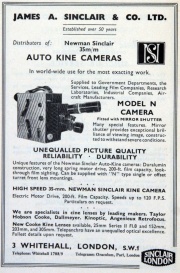James A. Sinclair and Co
James A. Sinclair and Co, photographic and scientific instrument makers, of 54 Haymarket, London. (1922)
of 9-10 Charing Cross, London, SW1. Telephone: Regent 6288. Cables: "Oraculum, London."
1904 James A. Sinclair was awarded a prize at the Louisiana Purchase Exhibition[1].
1909 Arthur Newman set up a new partnership with James A. Sinclair called Newman and Sinclair, and opened a workshop to manufacture film equipment that would be retailed by James A. Sinclair and Co, the best known being Newman and Sinclair's Una
Newman designed the Newman-Sinclair reflex camera, a lightweight design carrying 400 feet of negative in film boxes placed side by side.
1910 Herbert Ponting took one of the cameras on Captain Scott's ill-fated polar journey.
1922 Listed Exhibitor - British Industries Fair. Manufacturers of Newman and Sinclair N. S. Cameras, Iris Dissolvers, Tripods with Revolving and Tilting Tops, Film Perforators and Appliances for Kinematograph work. (Stand No G.61e) [2]
1929 Listed Exhibitor - British Industries Fair. Manufacturers of Photographic and Kinematographic Cameras, including the Sinclair "Una" in Standard and Tropical Models; the "N. S." Standard Kine' Camera with electric drive, and "N. S." Auto Kine' Camera taking 200ft. (35mm.) film. (Stand No. O.4) [3]
Newman and Sinclair continued on well into the 1950's, mainly focusing on Cine equipment.
See Also
Sources of Information
- ↑ The Times, 7 November 1904
- ↑ 1922 British Industries Fair p73
- ↑ 1929 British Industries Fair p152
- [1] Who's Who of Victorian Cinema

































